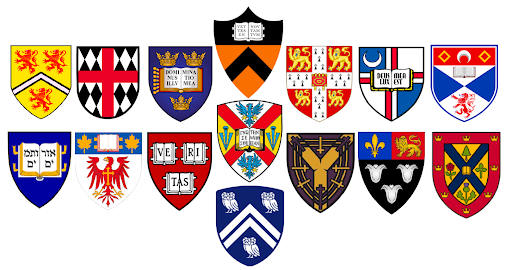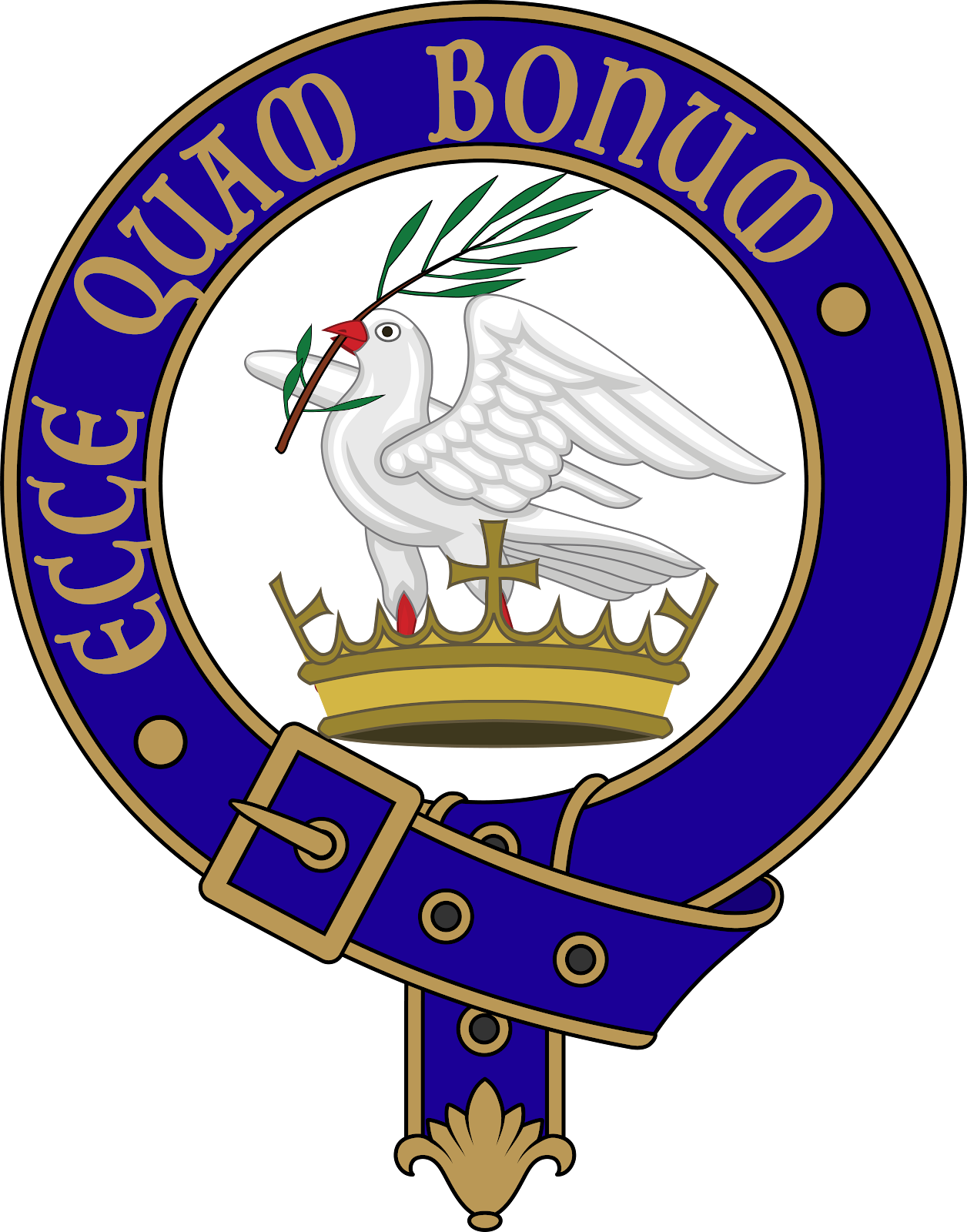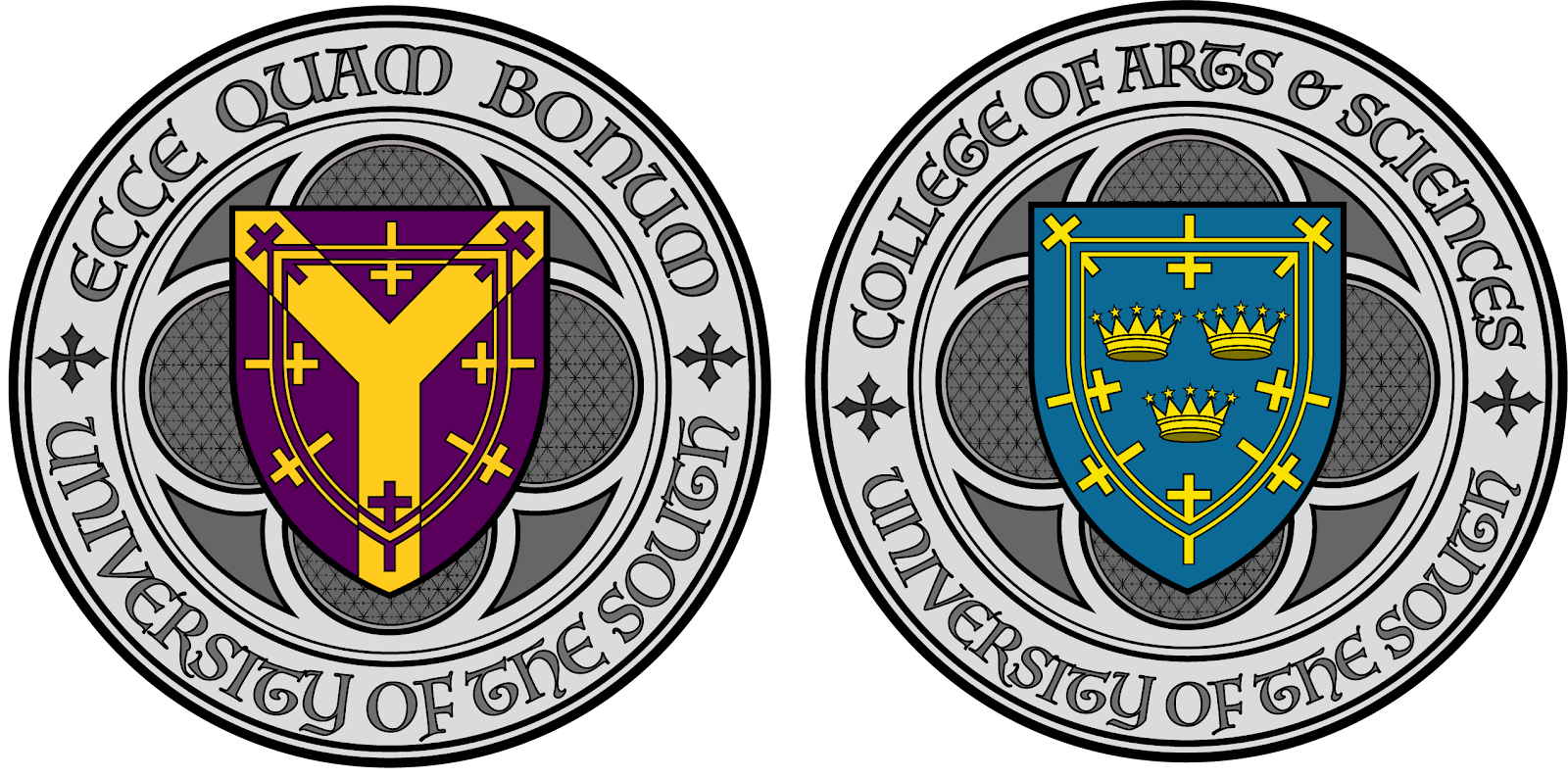 |
| The coat of arms of the University of Chicago Rendered by Chad Krouse, 2025 |
"In the first form of the coat-of-arms the book was placed upon the breast of the phoenix. It is so carved in many places in Harper Memorial Library. Further study of the design resulted in the decision to separate the book and the phoenix.
"The coat-of-arms of the University of Chicago is, therefore : argent, a phoenix displayed gules, langued azure, in flame proper. On a chief gules, a book expanded proper, edged and bound or. On dexter page of book the words, Crescat Scientia, inscribed, 3 lines in pesse sable. On sinister page the words, Vita Excolatur, inscribed, 3 lines in pesse sable" (124).
"The University Coat of Arms, a shield displaying the phoenix below and the book and motto above, was adopted by the Board of Trustees on August 16, 1910. The University motto Crescat scientia; vita excolatur was adopted by the Board on January 17, 1911 and added to the Coat of Arms on the pages of the open book."The Coat of Arms was designed by Pierre de Chaignon la Rose, a heraldic specialist in Boston working under contract to the Board of Trustees. No surviving documents make clear precisely why the phoenix was adopted as the central element on the Coat of Arms, but the most probable assumption is that the phoenix can be seen as a symbol of the city of Chicago, which was seriously damaged by the great Chicago Fire of 1871 and then was successfully rebuilt, or reborn, within just a few years" (Office of the Secretary, 2023 September 9).
La Rose Submits Three Designs
"In devising a seal for the University of Chicago, I am informed that it shall be heraldic, in accordance with ancient English, Continental, and American precedent. It will be necessary, then, before considering a seal as such, to establish heraldic bearings for the University, which will later be incorporated in the seal" (La Rose, 1910, 1).
"It should be clearly understood that the purpose of heraldry has never been to depict, by its charges, a specific object, but merely to typify in the most conventional manner possible, a class of objects.
"If it is desired to indicate the Founder’s Tower, the most scholarly way would be by means of the usual heraldic abstract convention—the chess form of tower. If, however, the authorities cannot bring themselves to this level of detachment, a kind of precedent for the Founder’s Tower can be found in the seals of several English municipal corporations (see the Book of Public Arms, by A.C. Fox-Davies), where in some cases are shown representations of presumably actual medieval structures" (La Rose, 1910, 1).
.jpg) |
| A close up view of la Rose's University of Chicago design #1 carved above the entrance portico of Harper Memorial Library, The University of Chicago. Image is from the University of Chicago website. |
"The heraldic charge, however, which in my opinion, will most clearly identify the arms of the University of Chicago, is the 'phoenix'--an eagle shaped bird rising from flames. And as the fundamental purpose of a coat of arms is simply to identify its owner ('Arma sunt distinguendi Causa'), and not, as is vulgary supposed, to symbolize his origin, history, achievements, aspirations, etc., any charge that can be regarded as peculiarly appropriate from this point of view, has the highest value" (2).
"In my first sketch (argent on a phoenix gules an open book of the first, edged and bound or), I have represented the University of Chicago in the simplest form, and therefore--to the herald--the best" (La Rose, 1910, 2).
"The University owed the motto of the coat-of-arms and the seal to Professor Paul Shorey. Mr. Shorey was thinking one day of that phrase in Tennyson's In Memoriam: 'Let knowledge grow from more to more,' and it impressed him as expressing one purpose of a university. He thereupon put it into Latin-Scientia crescat.
"Casting about for some phrase that would express the University's ideal of service, as Mr. Robertson of the Department of English wrote in the University of Chicago Magazine for June, 1912 , he was minded of the passage in the sixth book of the Aeneid, in which Vergil tells of seeing in the happy fields those who on earth enriched or adorned human life. [Inventas aut qui vitam excoluere per artes.] And so he got his second verb and subject. In putting the two parts together he related them in English by 'and so.'
"Hence Dr. Shorey offered as a motto for the University: Crescat scientia; vita excolatur. 'Let knowledge grow from more to more; And so be human life enriched.' The motto was welcomed and adopted" (467-468).
 |
| University of Chicago design #2 by la Rose in 1910. Image is courtesy of the Hanna Holborn Gray Special Collections, the University of Chicago Library, September 2023. |
 | |
|
"In determining the merits of these designs, they should be studied at a distance, and their relative effectiveness thus determined. The shield which is at a distance is the simplest and perspicuous--has the most 'carrying power'--is always the best heraldry. My own judgment places them in the order named" (4).
 |
| The opposite page of the final version of arms, as seen above in the introduction. Image is courtesy of the Hanna Holborn Gray Special Collections, The University of Chicago Library, September 2023. |
 |
| Letter from Office of Counsel and Business Manager to Mr. Horace S. Fiske, dated February 8, 1912 (I am unable to make out the signature) where in the post-script we learn of Sir Henry's origin. Click on the image to enlarge. Image is courtesy of the Hanna Holborn Gray Special Collections, The University of Chicago Library, September 2023. Click image to enlarge. |
"A further study of this design [University of Chicago design #1] brought forth the objection of English heralds that the position of the book [la Rose positioned the open book on the breast of the phoenix] was illogical, that although the phoenix could not be consumed by flames the book might be.
"Mr. Burke [Sir Henry] of London suggested the division of the field and the placing of the book in chief...Mr. Burke's modification has resulted in the form as published, and as carved in the staircase of the west tower of Harper" (244-245).
"A year or more ago, at the request of Mr. Charles Coolidge, the Architect, I designed a heraldic seal for the University of Chicago [likely University of Chicago design #1]. As I am preparing a column on corporate heraldry in America, I am curious to know whether or not the university ever adopted officially these arms. If so I should be very grateful if you could send me a print of the seal" (Letter from Pierre de Chaignon la Rose to the Secretary of the University of Chicago).
"My dear Mr. LaRose, the University of Chicago seal has at last been adopted. The charges are those which you know, the Phoenix and book. A restudy of the design [likey University of Chicago design #1] resulted in the shifting of the book to the position in chief. The seal will be published the 10th of June. At that time you will receive a copy of the magazine containing the final form. Your own share in proposing the design is mentioned in the article which accompanies the seal" (Letter from D.A. Robertson to Pierre de Chaignon la Rose).
The University of Chicago Magazine would be published the following month in June, and based on my reading of the article, this is the magazine Robertson refers to in his letter to la Rose. I shudder to think of la Rose's reaction to the heralds' critique of his design--that an open book charged on the breast of the phoenix might well burn (University of Chicago, 1912). Moreover, how chuffed would la Rose be knowing that he was being credited for a design he did not render?
And that's where the story concludes--from la Rose's phoenix rising up from the ashes to its eventual defeat by an English herald's chief. Yet, somehow, history has glossed over the facts and continues to credit la Rose for the final version of arms. The heralds in London do not typically work for free, and there would likely have been payment sent from the university or one of its benefactors to cover the costs involved for the restudy. Thus, there remains an important gap in the data: we simply do not know who from the university contacted the College of Arms, much less the rationale behind such a request for a restudy.
La Rose Versus Burke
 |
| The final version, or "restudy" of the arms for the University of Chicago designed by Sir Henry Farnham Burke (1859-1930) of the College of Arms between 1910-1912. Image is courtesy of the Hanna Holborn Gray Special Collections, The Library of the University of Chicago, September 2023. |
A few data points to consider. First, Goodspeed (1916) provides the blazon of the "restudied" arms which provide more details of how to render the phoenix. La Rose chose to render both the mythical bird and the open book in their simplest forms, and thus a shorter blazon.
"Mr. Burke [Sir Henry], of London, made a further study of the design [presumably la Rose's University of Chicago design #1], suggested a re-arrangement of the field.
"The resultant coat-of-arms is as follows: 'Argent, a phoenix displayed gules, langued azure, in flame proper. On a chief gules, a book expanded proper, edged and bound or. On dexter page of book the words Crescat scientia inscribed , three lines in pesse sable. On sinister page the words Vita excolatur inscribed, three lines in pesse sable'"(467).
 |
| Arms of the Episcopal Diocese of Atlanta. Rendered by Chad Krouse, 2024. |
.jpeg) |
| A modern emblazonment of the arms of the University of Chicago after Sir Henry's 1910-1912 "restudy." Image is from the University of Chicago website. |
Chicago. Chicago, University, 4800, 4801.
La Rose (Pierre DeChignon) designs:
Crescat Scientia, vita excolatur. [Coat of arms: shield with open book in band across top: spread-winged eagle below with flower] copyright 1 c. April 1, 1929: G538" (Library of Congress Copyright Office, 1929, 4809).
What does this mean? Based on my very limited knowledge of copyright laws, the image of the coat of arms as seen above in the introduction was formally copyrighted and attributed to la Rose--even though his middle name is misspelled and the flames are cited as a flower. Given the gap in the archive's holding regarding any response from la Rose to the Office of Secretary of the University, I wonder if any legal action was taken by la Rose or a mediated agreement reached between the two parties. Needless to say, those documents would not be released to the public--private universities are not subject to requests under the Freedom of Information Act unlike their public counterparts.
In a letter I came upon previously in the archives, but disregarded simply because it felt innocuous, dated July 11, 1911 from Office of Counsel and Business Manager to David A. Robertson, the Secretary of the University, we find:
"In regard to the publication of the Coat of Arms and Seal of the University in the July magazine, I want to call your attention to the fact that it has been our wish to have this copyrighted before it goes out. That action has been postponed pending approval of both by Mr. Ryerson. I will speak to Mr. Ryerson in regard to the matter and ascertain if it is still his wish to take that course" (Letter from Office of Counsel and Business Manager to David A. Robertson).
Now, however, this letter appears much more interesting and relevant. It seems the university had plans to copyright the arms as early as 1911--why wait until 1929 to formally submit materials for legal protection? Moreover, it would appear based on this letter, the magazine article announcing the new coat of arms would be delayed by one year, possibly caused by the restudy. We simply do not know the reason for these delays. I also begin to wonder why la Rose changed up his version of the phoenix and flames in 1920 for the Episcopal Diocese of Atlanta, was this change to avoid infringement or his growing appreciation of simple heraldry?
La Rose was proud of the work he did as a herald. I have several examples in my data of letters he penned to various editors in order to defend errant statements made regarding his work. Below is one timely example published in The Living Church, a month following the University of Chicago's magazine article announcing the new coat of arms:
To the Editor of The Living Church: A recent lecture of mine at St. John's Theological School, Cambridge, on Ecclesiastical Heraldry, has been variously reported in Church papers. Amateur reporting of so technical a subject is, of course, bound to be inaccurate. I find now that I am being credited with an attack on the coat of arms of the Diocese of Kansas City. As a matter of fact, I did not mention these arms in my discourse, for the reason that I myself designed them for the diocese! Obviously, then, I would be unwilling to attack them as unsound heraldry, and equally obviously am I prepared to defend them."
[The error referred to does not appear in the report of Mr. la Rose's address printed in The Living Church, in which Kansas City is not mentioned--Editor L.C.] (La Rose, 1912 July 13, 385).
La Rose is writing in reference to an article which appeared in the May 25, 1912 edition of The Living Church, and the editor's note is correct--I checked (The Living Church, 1912 May 25, 139). Was la Rose so incensed by how he was treated in Chicago that he fired off a letter to the editor but aimed at the wrong target? Again, we do not know.
From this example by la Rose, the reader will adduce the sharpness of his pen. My guess is that la Rose was still fuming from the university's magazine article that he would have received in June. La Rose would not relent on matters of heraldry, likely because had the utmost confidence in his sound methods for devising new corporate arms. There seems little doubt that la Rose would not have responded to the university's final version of arms as printed in University of Chicago (1912).
As of now, there is no data to fill in this rather interesting gap. Perhaps the reader can render a guess.






























.jpeg)









